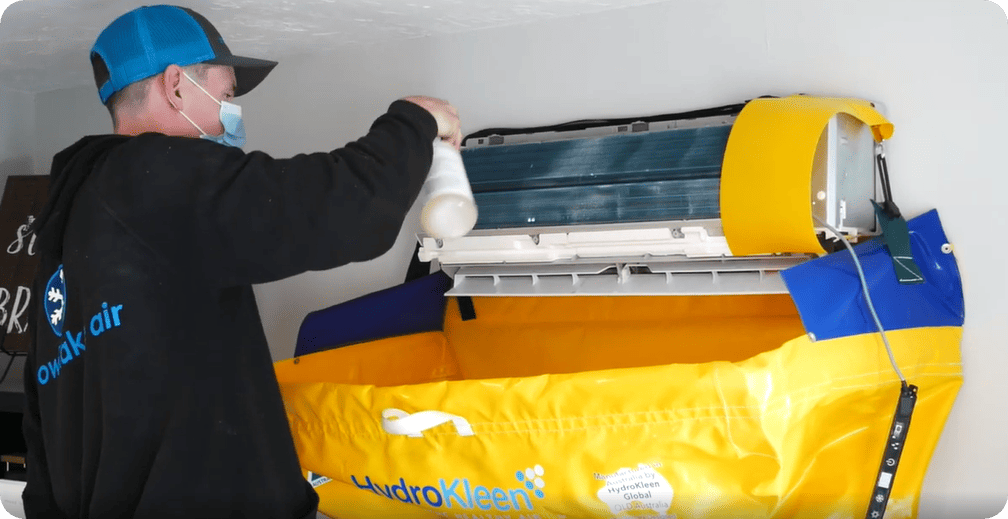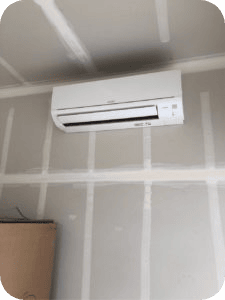Five Common Signs Of A Mold Problem In Your Home (And More)
Does Your Home Have A Mold Problem? Here’s What You Want To Look For
 Sure, everyone knows the clear signs of a severe mold problem at home: Big, ugly splotches, usually dark green or black, on a wall. Maybe it’s in the basement, or even upstairs if you’ve dealt with a leak.
Sure, everyone knows the clear signs of a severe mold problem at home: Big, ugly splotches, usually dark green or black, on a wall. Maybe it’s in the basement, or even upstairs if you’ve dealt with a leak.
But, that’s not the first sign of an issue. Far from it.
Mold tends to grow in out-of-the-way places, especially where there’s no light. So, you’re probably not going to notice a colony of spores right away when it’s growing behind the drywall or in a storage box.
In fact, by the time you do notice those significant visual signs, the problem’s already out of hand.
Instead, you need to keep an eye (and your other senses) out for those smaller and sometimes subtle clues that mold is growing in your home.
It can happen in any house, but homes that use mini split heating and cooling are even more at risk than others.
We’ll talk more about that a little later in this article. But first, we’re going through the common signs of mold in your home and some of the physical symptoms and health problems you can experience.
If you catch the problem fast enough, it’s possible to get rid of it on your own. And, with some extra care in the future, you’ll prevent it from coming back.
Five Telltale Signs Of A Mold Problem At Home
By the time you see mold growing on a wall or on furniture in your home,it’s already become widespread. Instead, look for these other telltale signs to catch a mold problem early on:
- Stale, Rotten Smell
- HVAC Smells
- Spots On Clothing
- Warped Walls
- Black Spots
Related: What Is The Best Temperature To Prevent Mold From Growing At Home?
Stale, Rotten Smell
 You can’t see mold growing behind your walls or inside your HVAC system, but you’ll be able to smell it. Spores in the air will have a stale, rotten smell to them.
You can’t see mold growing behind your walls or inside your HVAC system, but you’ll be able to smell it. Spores in the air will have a stale, rotten smell to them.
HVAC Smells
When it comes to heating and cooling, the odor caused by a mold colony has a specific name: Dirty Sock Syndrome.
That refers to the stale, cheesy smell you notice when your system circulates mold spores through the house. Check to see if the odor is more pungent around vents or near the air handlers of a ductless system.
Read More: Why Does My Mini Split Smell Like Cheese Or Dirty Socks?
Spots On Clothing
Mold can also grow on clothes, and you can spot it by watching for white or brown splotches on fabric that are squishy or fuzzy. It’s especially a problem if your clothes are still damp once they’re done in the dryer. Or if they’re tucked away in a box or drawer for a long time in a humid environment.
Warped Walls
Drywall is almost always used for interior walls in homes, and they’re porous. As a result, mold growing inside the wall will warp both sides of the drywall. So, even if the infestation is growing where you can’t see it, you’ll notice bulging and disfiguration on the side of the wall you can see.
Similarly, you may also notice bubbling and warping wallpaper.
Related: How Long Does Mold Remediation Take?
Black Spots
Once you start noticing black spots on a wall, particularly near the ceiling or in a corner, you know you’ve got a mold problem quickly getting out of hand.
It’s easiest to spot on finished walls because it stands out against the paint. But, spots on the walls or floor of a dark, unfinished basement can blend in more easily with stonework and mortar.
Four Physical Symptoms Of Mold Exposure At Home
Exposure to excess mold in your home will start to cause health problems including:
- Allergy Symptoms
- Trouble Breathing
- Rashes And Blemishes
- Sinus Headaches
Allergy Symptoms
 People with a mold allergy will respond to spores the same way people with seasonal allergies respond to pollen: Their immune system overreacts, and they experience runny noses, itchy eyes, a cough, and throat irritation.
People with a mold allergy will respond to spores the same way people with seasonal allergies respond to pollen: Their immune system overreacts, and they experience runny noses, itchy eyes, a cough, and throat irritation.
Trouble Breathing
Breathing in a foreign and potentially toxic substance like mold spores can make you nauseous and trigger asthma attacks. Anyone with a respiratory problem such as COPD is also more vulnerable to difficulty breathing due to mold exposure.
Rashes And Blemishes
A rash from mold looks like any other rash triggered by an allergic reaction. So, you’ll want to look for some of the other signs we discussed. But, the brown or pink blemishes are often itchy with small raised bumps. And, they can make your skin dry, scaly, and sensitive to the touch.
Sinus Headaches
Headaches and sinus problems are common with mold exposure or being allergic to it. The problem is twofold: Inflammation from the allergic reaction, plus irritation of your respiratory system both contribute to sinusitis and related problems.
Related: Can Mold Cause Vertigo?
How Long Do Mold Spores Live?
Mold spores live for centuries as long as there’s organic matter for food plus a suitable place to cultivate. Mold spores on clothes usually live for a day or two. But, they’ll keep multiplying and form a colony that keeps growing if the conditions are right in your home.
Mold Spores And Ductless Mini Splits
Over the last ten years, we’ve discovered that ductless mini splits — particularly the air handlers — are prime breeding grounds for mold. These units trap bacteria and other organic matter, which serves as food.
Plus, they’re dark, warm, and damp — the perfect environment for a colony to thrive.
And, to make things worse, those spores spread through the air you breathe every time the system starts blowing warmed or cooled air back into the room.
Related: How Often Should A Mini Split Be Cleaned?
For example, here’s a photo of an air handler we started cleaning. You can see the side of the coil we’ve treated versus the side we didn’t get to yet:

If you’ve had your mini split for more than a year, you should consider a deep cleaning. That’s especially so if you’re also noticing signs and symptoms of mold exposure in your Treasure Valley Home. If you want to schedule a cleaning, or just ask some questions to learn more about it, call HydroKleen208 at (208) 779-5596. We service the Boise Metro area along with Kuna, Cascade, and McCall, ID up in Valley County.

 The effects of mold exposure or mold toxicity range from mild physical ailments to possibly even serious neurological issues. So, as you take steps to remove mold from your home, it’s also important to focus on healing the damage your body has taken as a result of exposure.
The effects of mold exposure or mold toxicity range from mild physical ailments to possibly even serious neurological issues. So, as you take steps to remove mold from your home, it’s also important to focus on healing the damage your body has taken as a result of exposure.
 Your nose knows! A funky smell coming from your mini split is a sign of a problem. Depending on the odor, it could be anything from an electrical issue to mold infestation to a problem outside your home.
Your nose knows! A funky smell coming from your mini split is a sign of a problem. Depending on the odor, it could be anything from an electrical issue to mold infestation to a problem outside your home.
 Let’s face it: Mother Nature is no friend to people with asthma. Sure, manufactured chemicals and toxins may trigger attacks. But there are plenty of hazards in the natural world that do the same.
Let’s face it: Mother Nature is no friend to people with asthma. Sure, manufactured chemicals and toxins may trigger attacks. But there are plenty of hazards in the natural world that do the same. There are many possible reasons why your mini split isn’t blowing hot air or warming your home. Most of them boil down to buildup inside the air handlers that prevent airflow or heat transfer. Now, there’s an easy fix for that.
There are many possible reasons why your mini split isn’t blowing hot air or warming your home. Most of them boil down to buildup inside the air handlers that prevent airflow or heat transfer. Now, there’s an easy fix for that.